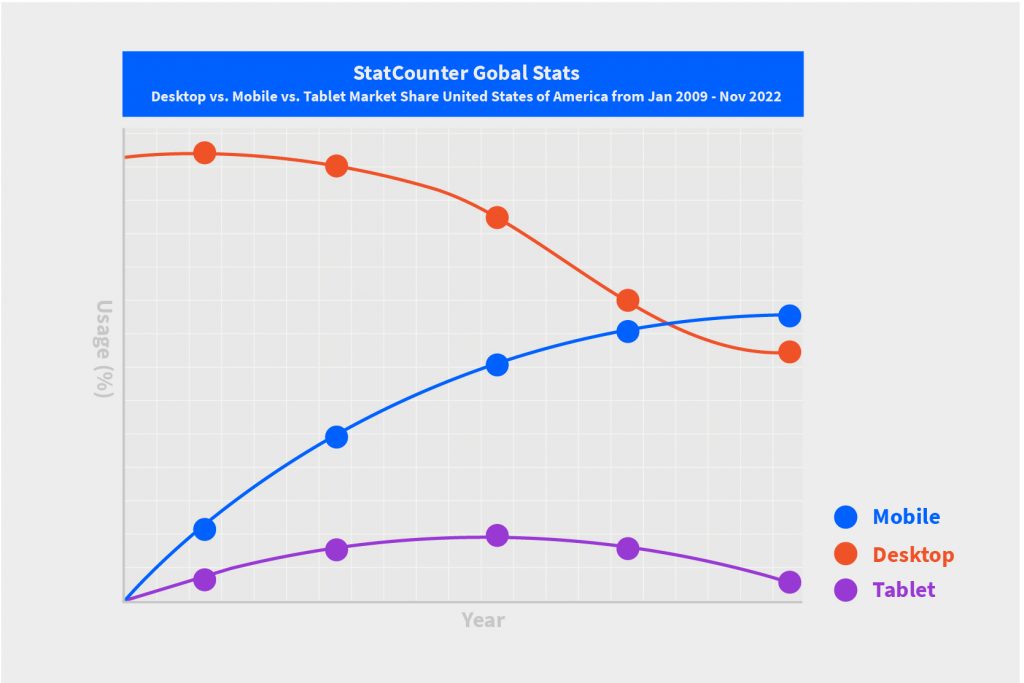According to a Deloitte survey, the number of smart devices in the average US home has more than doubled since 2019. People use them to get online from wherever they are, using whichever device happens to be available to them at the time. Those devices can include smartphones, connected TVs, smart speakers, laptops, and more.
This is why cross-device ad targeting is so important. This ad targeting strategy makes it possible for you to reach the same user across their different devices. Read on to learn insights about device usage, how cross-device ad targeting works, and the benefits of this strategy.
Breaking Down Device Usage
According to data from Deloitte, the average US household in 2022 has a total of 22 connected devices. In every home, individuals are using multiple devices, like smartphones, connected TVs, and laptops, to connect, watch, and listen online.
As you can see in the chart below, device usage is always evolving. While the amount of time spent with specific devices changes year-to-year, one thing is constant: Users are splitting their time across different devices.

People today have more devices than ever before, and they spend more time with those devices than ever before, too. Since 2013, daily screen time has increased by nearly 50 minutes per day. Now, the average American spends 7 hours and 4 minutes looking at a screen every day.
With consumers looking at a variety of screens throughout their day, a consumer’s buying journey is likely to involve multiple devices. This is where cross-device ad targeting comes in.
What is Cross-Device Ad Targeting
Cross-device ad targeting is the practice of serving digital ads to the same consumer across multiple devices. Marketers leverage cross-device tracking in order to implement their digital strategy across multiple devices.
How Does Cross-Device Targeting Work
Cross-device targeting is a strategy that works by leveraging cross-device tracking. Cross-device tracking is the method that marketers rely on to identify users across different devices.
Cross-device tracking can be done through one of two methods: Deterministic or probabilistic. The goal of each method is the same. To confirm if multiple devices, like a mobile phone, connected TV, and a desktop computer, all belong to the same user.
Let’s break down the two methods for cross-device tracking:
Deterministic
Deterministic cross-device tracking relies on consumer logins as an identifier to match consumers’ devices to one user. This method tends to be pretty accurate since consumer login information is unique to an individual. Since this method of cross-device tracking relies on a user logging into a website or app on multiple devices, it can be somewhat limited in reach.
Probabilistic
Probabilistic cross-device targeting uses models and algorithms to identify a consumer across devices. It leverages non-personal data points like IP address, time of day, device type, cookies, and other identifiers to infer whether or not two devices are in use by the same individual. Probabilistic is a good alternative to deterministic cross-device tracking when you don’t have enough data to deterministically link users to multiple devices.
Benefits of Cross-Device Targeting
In today’s consumer landscape, it’s important to leverage the entire digital world in your advertising strategy. Cross-device ad targeting is one strategy that helps marketers achieve this. Let’s explore its key benefits.
Improved Ad Targeting
Cross-device targeting ensures that regardless of what device a user is on, they will encounter your ad. You’re able to be wherever your audience is, which could be on various devices and channels. Your audience has more opportunities to engage with your brand, driving them further into the funnel.
Increased Engagement
Cross-device ad targeting can drive higher engagement with your campaigns. Your ads appearing across devices means that your audience will have the chance to engage in the moment that is best for them. It may be convenient for them at home to engage with your ad on their laptop, but if they’re in transit, mobile might be the better option.
Measurement Capabilities
Cross-device targeting provides you more insights into the effect of your programmatic campaigns, across devices. With this granular data, you’re able to see when and where a user converted, what drove them to take your desired action, where they may have dropped off, and what platform or promotion they were most influenced by.
Cross-Device Targeting in a Multi-Channel Strategy
In today’s advertising landscape, marketers should be leveraging the entire digital world. Ignoring the variety of devices that users now spend time with means missed opportunities for your messaging to reach your target audience.
Along with cross-device targeting, you can use a multi-channel targeting strategy to make sure you reach your ideal audience on a mix of devices, and on a mix of programmatic channels like audio, in-game advertising, and video. A multi-channel strategy helps you to gain greater reach by capturing users who are only using some channels.
With programmatic, cross-device ad targeting and multi-channel distribution is easier than ever. Both strategies are powerful tools for ensuring you reach your audience across all programmatic channels on their desktop, mobile, tablet devices, and connected TVs.
Want to get started with cross-device ad targeting? Request a demo to learn more about StackAdapt.





